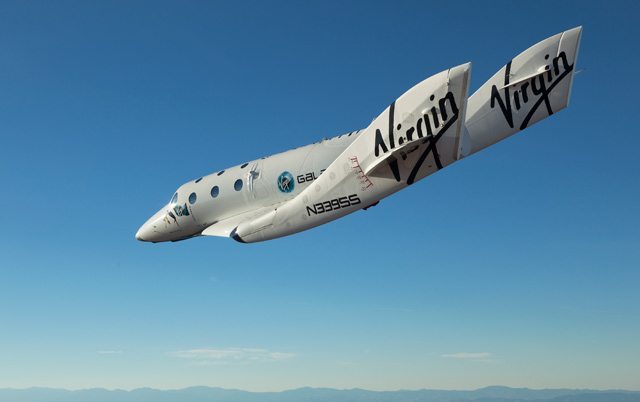Virgin Galactic has formally backed away from its pledge to put its first fare-paying passengers into suborbital space by the close of 2014 – but has made a very public declaration that suborbital operations from its purpose-built spaceport in New Mexico will begin in early 2015.
Billionaire Richard Branson, the serial entrepreneur and Virgin Atlantic airways boss who has spent a decade working to make Virgin Galactic a reality, told US television talk show host David Letterman: “I’ll be on the first flight from New Mexico.” And, he added, that flight – which, as he has long insisted, will carry him and his family, will happen “in February or March” 2015.
However, the prospect of Virgin Galactic’s six-passenger, two-pilot SpaceShipTwo reaching space during 2014 – from the company’s test and development facility in Mojave – appears to remain a possibility. Speaking to Letterman on the 9 September edition of his Late Night programme, Branson also said: “From now until March [2015], there will be many test flights, many test flights into space.”
Ironically, for a company fronted by an entrepreneur who is as famous for his marketing flair and public persona as for his business acumen, the company is notoriously tight-lipped about its development programme. Thus, outside observers might reasonably wonder whether or not Virgin Galactic has reached a high enough stage of technical readiness to get SpaceShipTwo into space on such a tight timetable.
To date, SpaceShipTwo – drop-launched from 46,000ft by WhiteKnightTwo, a twin-fuselage, all-composite “mothership” designed and built by Scaled Composites – has made three supersonic flights. On the third flight, on 10 January 2014, a 20s rocket burn pushed the craft to Mach 1.4 and its highest-yet altitude of 71,000ft.

Virgin Galactic
To reach suborbital space, however, SpaceShipTwo’s rocket motor will have to push it nearly five times higher, beyond 100km, or some 330,000ft.
And it was only as recently as May 2014 that Virgin Galactic selected the rocket fuel it would use for the remainder of its flight test programme and commercial operations. The choicer of a “polyamide-based fuel grain”, said the company at that time, was made following “numerous ground test firings and is supported by data collected over an extensive development programme”.
More recent operations have involved flight tests for WhiteKnightTwo. Earlier this month, the aircraft was flown to New Mexico for two days of flying in the local airspace it will navigate when operating from Spaceport America. According to Virgin Galactic, the flights, intended to familiarise pilots and team members with “scheduling and the New Mexico airspace”, included “several simulated launch profiles, spaceship approaches and a divert to El Paso airport”.
Though unable yet to elaborate on the development programme, a spokesperson said Virgin Galactic does indeed have a “navigable path” to reach space by year-end – but not necessarily for a flight with Branson on board.
HARD SLOG
Whether Virgin Galactic makes it to space by the end of 2014 or early in 2015 – in a test flight or in Branson and family’s trial of the commercial service – is not, at this stage in the programme, particularly significant. Clearly, what matters is that the company is able to do what it has been promising for nearly 10 years. As Branson told Letterman earlier this month, 800 people have signed up for a flight – which is about 200 more than it had on its waiting list at the end of 2013. All are understood to have paid deposits, and an unspecified number have paid the full $250,000 fare to spend about 6min outside the atmosphere in advance.
Delays have become a regular feature for Virgin Galactic, which in summer 2008 declared that it expected to start operations in about 18 months. Citing its primary concerns for safety, the company has been pushing back that commencement date ever since.
The scale of the project should not be underestimated. Though the basic mission profile was well established more than 50 years ago by the NASA-US Air Force X-15 programme – a comparison encouraged by Virgin Galactic chief executive George Whitesides – the challenge of doing it economically and safely with a much larger, passenger-carrying vehicle is clearly great.
The Virgin Galactic idea got its start when Branson agreed to sponsor Scaled Composites’ successful 2004 bid to win the Ansari X-Prize, for being the first private operation to cross the widely accepted 100km altitude border to space twice within two weeks, in a reusable vehicle capable of carrying three people. SpaceShipTwo and WhiteKnightTwo are, essentially, bigger versions of the X-Prize craft, but scaling up has not been straightforward. In 2007 a rocket oxider cold flow test accident killed three Scaled Composites workers in Mojave and at least one point in the carrier aircraft’s early test flight campaign, a runway incident resulting in some landing gear damage raised questions about stability.
Branson, however, has a truly grand vision for his spaceflight company – and no shortage of backers. The Norman Foster-designed Spaceport America, with 3,660m (12,000ft) runway, was built with a $200m special tax levy by the state of New Mexico in a bid to establish itself as the centre of a burgeoning new industry. At the 2012 Farnborough air show, Virgin Galactic and Surrey Satellite Technology agreed to collaborate on a plan, called Launcher One, to use WhiteKnightTwo and an underslung rocket booster to slash the cost of launching small satellites.
And, if Branson’s vision aligns with reality, the business plan goes much further. As he told David Letterman, orbital flights will come “in time”, adding: “What we’re dreaming about making possible is to transport people point to point.”
Source: FlightGlobal.com























